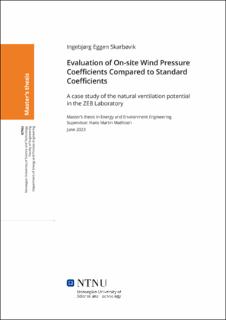| dc.contributor.advisor | Mathisen, Hans Martin | |
| dc.contributor.author | Skarbøvik, Ingebjørg Eggen | |
| dc.date.accessioned | 2023-09-26T17:20:22Z | |
| dc.date.available | 2023-09-26T17:20:22Z | |
| dc.date.issued | 2023 | |
| dc.identifier | no.ntnu:inspera:142431124:57332515 | |
| dc.identifier.uri | https://hdl.handle.net/11250/3092163 | |
| dc.description.abstract | Byggesektoren er i dag den største energiforbrukende sektoren i tillegg til å være en stor bidragsyter til CO2-utslipp. En betydelig mengde av denne energien brukes til oppvarming, kjøling og varmtvann til husholdningsbruk. Ved å integrere løsninger som solcellepaneler for lokal elektrisitetsproduksjon, optimalisert dagslys og naturlig ventilasjon som klimaanlegg, kan bygninger oppnå et komfortabelt innemiljø samtidig som energikostnadene reduseres. Nullutslippsbygg (ZEB) er bygninger der løsninger og teknologi benyttes for å kompensere for bygningenes klimagassutslipp i løpet av levetiden. ZEB-laboratoriet lokalisert på Gløshaugen i Trondheim er et eksempel på et slikt bygg og er et kontorbygg med faste arbeidsplasser. Bygget skal brukes til forsøk på energiproduksjon, ventilasjon, oppvarming og kjøling, med mer. Denne masteroppgaven skal undersøke effekten av å bruke spesifikke vindtrykkskoeffisienter for bygget sammenlignet med standardkoeffisienter i simuleringer. Naturlig ventilasjon er implementert i bygget gjennom en vinduskontrollalgoritme.
En viktig del av denne masteroppgaven var å evaluere vindtrykkskoeffisientene, som er spesifikke for ZEB-laboratoriet. 15 differensialtrykksensorer og en referansesensor ble brukt for å måle trykkforskjellene mellom innsiden og utsiden av bygget. Målingene ble utført i 10 uker, og de resulterende trykkene ble brukt til å beregne koeffisientene til bygget. Usikkerhet med utstyret som ble brukt og begrenset tilgang på tilstrekkelig data til bruk i beregningene resulterte i varierende grad av pålitelighet med vindtrykkskoeffisientene. Forbedring av resultatene kan oppnås ved å gjennomføre differensialtrykkmålingene over lengre tid for å samle mer data.
Vindtrykkskoeffisientene fra evalueringen ble lagt inn i IDA ICE, og simuleringer ble gjennomført i en uke i slutten av juli med en forenklet modell av ZEB-laboratoriet. En vinduskontrollalgoritme ble implementert i modellen for å tillate naturlig ventilering gjennom automatiske vinduer i bygningen. Simuleringene avdekte minimale forskjeller mellom de spesifikke trykkoeffisienter til bygget og standard koeffisienter, og begge simuleringene resulterte i et akseptabelt innemiljø med alle parametere innenfor det akseptable området, og ingen arbeidstimer der temperaturen oversteg 26°C. Videre er trekkrisikoen i bygget vurdert til å være lav i løpet av en typisk dag med lave vindhastigheter om sommeren. Forskjellene mellom de to settene med koeffisienter kan tilskrives lave vindhastigheter i løpet av den simulerte uken, hvor oppdriftseffekten vil være den viktigste bidragsyteren til naturlig ventilasjon i bygget.
Simuleringsresultatene indikerer at vinduskontrollalgoritmen fungerer etter hensikten for å tillate naturlig ventilering av ZEB-laboratoriet. Algoritmen ble imidlertid utviklet for bruk i kjølesesongen, og det kan gjøres endringer i settpunktene for å optimalisere bruken av naturlig ventilasjon i fyringssesongen. | |
| dc.description.abstract | The building sector is currently the largest energy-consuming sector and a big contributor to CO2 emissions. A significant amount of this energy is used for heating, cooling, and domestic hot water. By integrating solutions such as PV panels for local electricity production, optimized daylighting, and natural ventilation as air conditioning, buildings can achieve a comfortable indoor environment while also reducing energy costs. Zero emission buildings (ZEB) are buildings where solutions and technology are utilized to compensate for the greenhouse gas emissions of the buildings during their lifetime. The ZEB Laboratory located at the Gløshaugen campus in Trondheim is an example of such a building, and is an office building with permanent working spaces. The building is used for experiments on energy production, ventilation, heating and cooling, and more. This Master's thesis aims to investigate the effect of utilizing on-site wind pressure coefficients compared to standard coefficients in simulations. Natural ventilation is implemented in the building through a window control algorithm.
An important part of this Master's thesis was to evaluate the on-site wind pressure coefficient specific to the ZEB Laboratory. 15 differential pressure sensors and a reference sensor were used to measure the pressure difference between the inside and outside of the building. The measurements were conducted for 10 weeks, and the resulting pressures were used to calculate the specific coefficients of the building. Uncertainties with the equipment and a limited amount of sufficient data available to use in the calculations resulted in varying degrees of reliability with the wind pressure coefficients. Improvement in the results can be achieved by conducting the pressure measurements for a longer period of time to gather more data.
Wind pressure coefficients obtained from the evaluation were incorporated into IDA ICE, and simulations were carried out for one week at the end of July with a simplified model of the ZEB Laboratory. A window control algorithm was implemented in the model to allow for natural ventilation through automatic windows in the building. The simulations revealed minimal differences between the on-site and standard pressure coefficients, and both simulations resulted in an acceptable indoor environment with all parameters within the acceptable range, and no occupational hours where the temperature exceeded 26°C. Furthermore, the draught risk in the building was found to be low during a day with low wind velocities during the summer. The differences between the two sets of coefficients could be attributed to low wind velocities during the simulated week, where the buoyancy effect will be the main contributor to natural ventilation in the building.
The simulation results indicate that the window control algorithm works as intended to allow natural ventilation of the ZEB Laboratory. However, the algorithm was developed for use during the cooling season, and modifications can be made to the setpoints to optimize the use of natural ventilation during the heating season. | |
| dc.language | eng | |
| dc.publisher | NTNU | |
| dc.title | Evaluation of On-site Wind Pressure Coefficients Compared to Standard Coefficients
- A case study of the natural ventilation potential in the ZEB Laboratory | |
| dc.type | Master thesis | |
